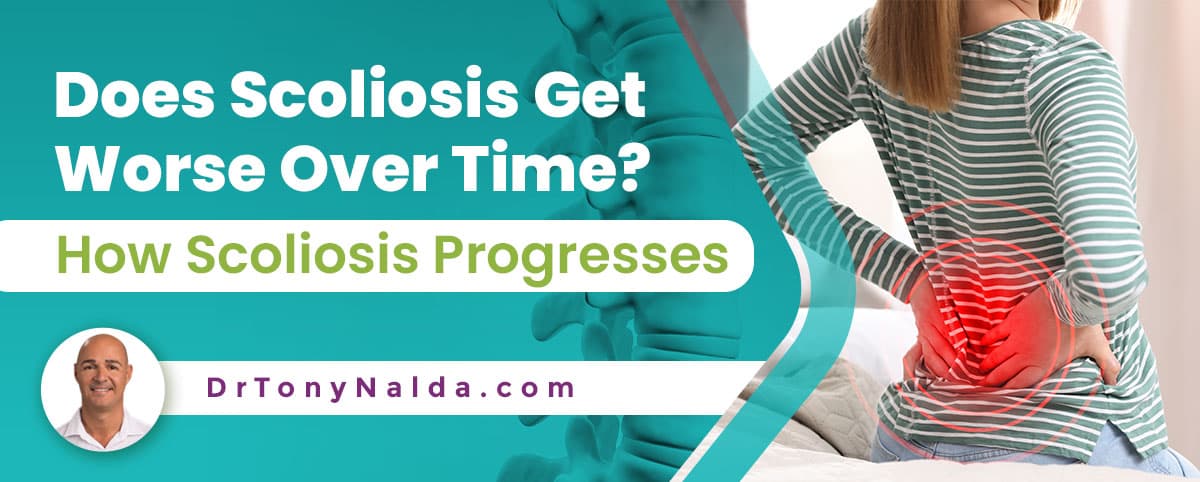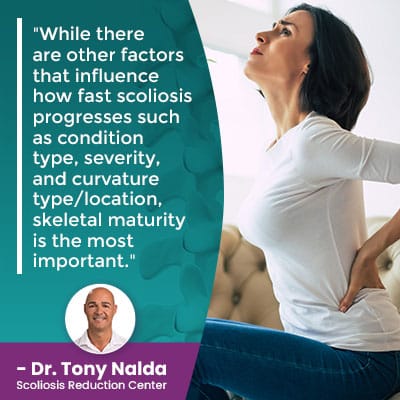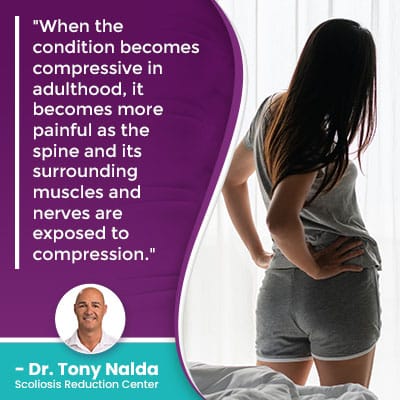Does Scoliosis Get Worse Over Time? How Scoliosis Progresses

While scoliosis is incurable, it is highly treatable, and a focus of treatment, particularly in children, is counteracting the condition's progressive nature, which means stopping the unnatural spinal curve from increasing in size.
Scoliosis is a complex condition, not only because it has multiple condition types and severity levels, but also because of its progressive nature. Progressive conditions get worse over time, especially if not treated proactively. The main trigger for progression is growth.
Let's start our discussion of how scoliosis progresses by first exploring the parameters that have to be met in order to reach a scoliosis diagnosis.
Table of Contents
How is Scoliosis Diagnosed?
In order to reach a scoliosis diagnosis, certain condition characteristics have to be present; after all, there are a number of spinal conditions that involve a loss of the spine's healthy curves.
Scoliosis means an unhealthy lateral (sideways) spinal curve has developed, with rotation, and it's the spine's unnatural twist that makes it a 3-dimensional condition.
In addition, in order to be considered a true scoliosis, the unnatural spinal curvature has to be of a minimum size: Cobb angle measurement of at least 10 degrees.
A patient's Cobb angle is a measurement taken during X-ray that tells me how far out of alignment the spine is, and classifies condition severity:
- Mild scoliosis: Cobb angle of between 10 and 25 degrees
- Moderate scoliosis: Cobb angle of between 25 and 40 degrees
- Severe scoliosis: Cobb angle of 40+ degrees
- Very-severe scoliosis: Cobb angle of 80+ degrees
As a progressive condition, where a patient's scoliosis is at the time of diagnosis is not indicative of where it will stay.
Scoliosis is Progressive
As a progressive condition, scoliosis is virtually guaranteed to get worse over time, especially if left untreated, or not treated proactively (as in a traditional treatment approach).
Scoliosis progression means even conditions diagnosed as mild can easily progress and become moderate, severe, or very severe; only proactive treatment can work towards preventing scoliosis progression.
So the next logical question is, what's the number one trigger for progression?
The main trigger for progression is growth and development, which explains why the condition's most-prevalent form is adolescent idiopathic scoliosis (AIS), diagnosed between the ages of 10 and 18.
Adolescents are at a higher risk for rapid progression because of the stage of puberty: characterized by rapid and unpredictable growth spurts.
So when treating scoliosis, patient age is a big factor when it comes to a patient's rate of progression; the goal is to stay ahead of a patient's progressive line.
 While there are other factors that influence how fast scoliosis progresses such as condition type, severity, and curvature type/location, skeletal maturity is the most important.
While there are other factors that influence how fast scoliosis progresses such as condition type, severity, and curvature type/location, skeletal maturity is the most important.
When treating childhood scoliosis patients with more growth yet to go through, the goal is to prevent scoliosis from getting worse, despite constant growth, and when treating scoliosis in adults and older adults, progression is still an issue, but the treatment focus shifts somewhat; let's explore the difference.
Preventing Progression in Adolescent Idiopathic Scoliosis
Idiopathic scoliosis is the main type to affect both children and adults, and as adolescent idiopathic scoliosis is the most prevalent, let's focus on progression in AIS and adult scoliosis.
When it comes to managing progression, there are two main treatment approaches for patients to choose between, and they offer patients different potential outcomes: traditional treatment approach and a modern conservative approach.
For those on the path of traditional treatment, watching and waiting is the common recommendation, but this amounts to merely observing while a condition progresses, and to me, is wasting valuable treatment time.
In addition, scoliosis becomes more complex to treat as it becomes more severe. Spinal rigidity increases with progression, making the spine less responsive to treatment.
In order to actively treat scoliosis, treatment has to start as close to the time of diagnosis as possible, in the best interest of staying ahead of a condition's progressive line.
While early detection doesn't guarantee treatment success, it does increase its chances if the diagnosis is met with proactive treatment.
Proactive Conservative Treatment
Here at the Scoliosis Reduction Center, many of my patients are adolescents, and the main focus of AIS treatment is achieving a curvature reduction on a structural level and holding it there, despite the constant progressive trigger of growth.
I integrate multiple treatment disciplines to impact conditions on every level, and through a series of condition-specific chiropractic adjustments, I work towards repositioning the most tilted vertebrae back into alignment with the rest of the spine.
As it's not just the spine that's in charge of maintaining its natural curves and alignment, but also its surrounding muscles, using a variety of physical therapies to increase core strength means the spine is getting optimally supported.
As the condition doesn't become compressive, and overly painful (most cases), until skeletal maturity has been reached, the main symptom of adolescent idiopathic scoliosis is postural deviation:
- Uneven shoulders
- Uneven shoulder blades with one shoulder blade protruding more than the other
- The development of a rib arch
- Uneven hips
- Arms and legs that appear to hang at different lengths
Postural deviation happens as a result of the uneven forces that scoliosis introduces to the spine and body, disrupting its overall symmetry.
If scoliosis is getting worse in adolescents, postural changes tend to become more noticeable, and large curves tend to progress more quickly.
Corrective bracing is another facet of treatment that's known to be particularly effective on growing spines; through the use of corrective bracing, corrective results can be augmented by pushing and holding the spine in a corrective position.
Once a significant curvature reduction has been achieved and core strength has been increased, corrective bracing and a home-rehabilitation program, consisting of custom-prescribed home exercises, can work to further stabilize and rehabilitate the spine.
So now that we know what triggers progression in adolescents, and how it can affect scoliosis symptoms, let's talk about progression in adults.
Progression in Adult Scoliosis
As mentioned, growth is the condition's main trigger for progression, so what happens with older adults and patients who are no longer growing? The condition is still progressive, but the rate of progression tends to slow down.
The two main types of scoliosis to affect adults are idiopathic and degenerative scoliosis; idiopathic scoliosis in adults are cases of AIS that went undiagnosed and untreated during adolescence, and degenerative scoliosis is caused by natural age-related spinal degeneration.
As the trigger of growth is removed, progression tends to slow in adulthood, but once spinal degeneration comes into play, rates can increase as the spine becomes less stable with age.
As the spine becomes less stable, it's going to be less able to maintain its natural and healthy alignment, and the condition is likely to become more painful as spinal rigidity increases with progression, as can muscle strain/imbalance.
 When the condition becomes compressive in adulthood, it becomes more painful as the spine and its surrounding muscles and nerves are exposed to compression.
When the condition becomes compressive in adulthood, it becomes more painful as the spine and its surrounding muscles and nerves are exposed to compression.
This is why adult idiopathic scoliosis that progressed from AIS is so common; adulthood is when the condition tends to become more noticeable because of pain.
A growing spine is experiencing a constant lengthening motion, which counteracts the compressive force of the unnatural spinal curve: the main cause of condition-related pain.
The lack of pain in many cases of adolescent idiopathic scoliosis is also why early detection isn't always easy to accomplish.
So when it comes to the progression of adult scoliosis, treatment plans aren't as focused on achieving large curvature reductions and counteracting progression as much as reducing a curve back to where it was before becoming symptomatic, preserving spinal function, pain management, and further stabilizing the spine.
Conclusion
So does scoliosis get worse over time? Yes, it's virtually guaranteed to do so, particularly if left untreated, or not treated proactively.
When it comes to preventing progression, we're talking about counteracting the increasing size of the unnatural spinal curve, and while a traditional approach to scoliosis treatment commonly funnels patients towards spinal fusion surgery, modern conservative treatment success is reached through proactive and integrative treatment plans.
The biggest trigger for scoliosis progression is growth, which is why young patients are at risk for rapid-phase progression, and close monitoring and proactive treatment started as close to the time of diagnosis as possible means treating the curve while it's smaller, more flexible, and simpler to treat.
While scoliosis is incurable and progressive, it is highly treatable, and effective conservative treatment strives to, first and foremost, impact it on a structural level, and works towards increasing core strength for optimal spinal support.
When it comes to preventing progression in adolescents, treatment focuses on monitoring for progression, achieving a large curvature reduction to counteract the condition's progressive nature, and holding the reduction throughout growth.
When it comes to preventing progression in adults, as the progressive rate tends to slow once skeletal maturity has been reached, monitoring closely for progression is not as prime a focus, and while achieving a curvature reduction is always the goal, the focus is more on reducing it back to where it was prior to becoming painful, managing pain, and stabilizing the spine.
While it's the nature of scoliosis to get worse over time, it doesn't have to, not with the benefits of early detection and the treatment success of a conservative chiropractic-centered approach.
Dr. Tony Nalda
DOCTOR OF CHIROPRACTIC
After receiving an undergraduate degree in psychology and his Doctorate of Chiropractic from Life University, Dr. Nalda settled in Celebration, Florida and proceeded to build one of Central Florida’s most successful chiropractic clinics.
His experience with patients suffering from scoliosis, and the confusion and frustration they faced, led him to seek a specialty in scoliosis care. In 2006 he completed his Intensive Care Certification from CLEAR Institute, a leading scoliosis educational and certification center.
About Dr. Tony Nalda
 Ready to explore scoliosis treatment? Contact Us Now
Ready to explore scoliosis treatment? Contact Us Now





